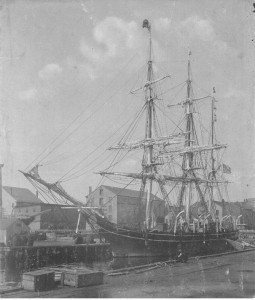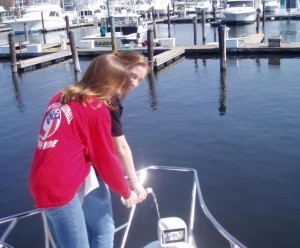Honoring Nautical Tradition

The Whaling Bark Sunbeam at the Pier in New Bedford, MA - Photo New Bedford Whaling Museum
I was writing a review of a Mainship trawler recently and while looking over the boat I noticed an actual Sampson post mounted behind the anchor windlass at the bow. A Sampson post is not unheard of but is somewhat less common on recreational boats these days. Most contemporary boaters will tie off their anchor rode to the post in order to relieve strain on the windlass capstan while at anchor. And it is also used when the boat is being towed. I'm sure most readers know these things about a Sampson post, even if they may not know that it served an even more central role aboard the tall sailing ships of earlier centuries. Except for workboats, today it is often just an artifact of nautical tradition. But seeing it on this contemporary trawler reminded me of a bit of historical research I did when planning the christening ceremony for my own boat back in 2003.
Our kids were still young teenagers then and we decided to take advantage of our Long Island location and buy a boat for the family to cruise the Northeast waters. It was a new build and rolled off the factory floor in March of 2004 and then was ferried from New Jersey to the dealer's marina on Staten Island. An earlier family history project had uncovered my great-grandfather's epic, nearly four-year voyage aboard a New Bedford whaling bark called the Sunbeam. So there was little question what we would name our new boat, even if we were happy that, with some small exceptions, the whaling business was no longer a condoned practice, or a current employer of any family member.
I wrote to the New Bedford Whaling Museum to ask one of the historians there what the christening ceremony of the original Sunbeam might have entailed. Fortunately for me, next to the Charles W. Morgan, which exists still as a floating whaling museum in Mystic, Connecticut, Sunbeam was one of the most well-documented whalers of the late 19th century. The Museum's historian sent me a detailed description of the ceremony along with some background on the practices of the day.
If you're wondering at this point what this has to do with Sampson posts, here's the (modest) payoff. Christening a whaler in the mid-1800′s involved smashing a bottle of rum on the Sampson post in a ceremony that involved mingling the symbolic prosperity and lifeblood of the sailors with the most stout piece of structure on the ship — the Sampson post. The newly christened Sunbeam then slid down the ways into Mattapoisett (MA) harbor. Some 20 years later, my 17-year old great-grandfather, George Nelson Tripp, left New Bedford on a voyage that took him to the Indian Ocean and back in search of whale oil.
Back to the future again and it is April of 2004 and my family is gathered at the bow of our own Sunbeam, at the dealer's dock on Staten Island. We decided to adapt the ceremony of the original Sunbeam for our own use.

Allie and Emily Tripp Christen the 2004 Silverton Motoryacht Sunbeam
My daughters Allie and Emily read the following as the final part of the ceremony, while pouring the rum over our anchor windlass (which I promptly rinsed with fresh water in a fit of new boat-owner paranoia):
"As the great-great-granddaughters of the original Sunbeam crew, we hereby name this ship "Sunbeam," and ask her to safely carry her crew and guests to the sea and back. This rum symbolizes the life and prosperity of her original sailors and blesses her name. May she always find fair winds and following seas. Ladies and gentlemen, man this ship and take her to sea."
Share on Facebook



